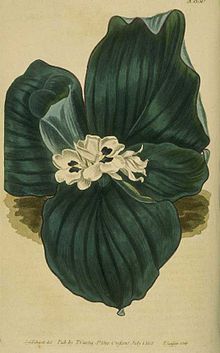গাঁঠিয়ন
গাঁঠিয়ন বা কেম্পফেৰিয়া গলাংগা (বৈজ্ঞানিক নাম: Kaempferia galanga) আদাজাতীয় একক স্ত্ৰীকেশৰযুক্ত উদ্ভিদ আৰু গলাংগাল নামৰ চাৰিবিধ উদ্ভিদৰ ভিতৰত অন্যতম। ইয়াক প্ৰধানকৈ ইণ্ডোনেছিয়া, দক্ষিণ চীন, টাইৱান, কম্বোডিয়া আৰু ভাৰতৰ মুকলি অঞ্চলসমূহত পোৱা যায় যদিও সমগ্ৰ দক্ষিণ-পূব এছিয়াতে ইয়াৰ খেতি ব্যাপকভাৱে কৰা হয়।
| গাঁঠিয়ন | |
|---|---|

| |
| বৈজ্ঞানিক শ্ৰেণীবিভাজন | |
| Unrecognized taxon (ঠিক কৰক): | Kaempferia |
| প্ৰজাতি: | K. galanga |
| দ্বৈৰাশিক নামকৰণ | |
| Kaempferia galanga L. | |
ৰন্ধন আৰু চিকিৎসাত ব্যৱহাৰ
সম্পাদনা কৰকইণ্ডোনেছিয়াৰ ৰন্ধন প্ৰণালীত গাঁঠিয়নক মছলা হিচাপে ব্যৱহাৰ কৰা হয়। তাত ইয়াককেনকুৰ আৰু মালয়েছিয়াত চেকুৰ বুলি কোৱা হয়। বিশেষকৈ জাভা আৰু বালিৰ ৰন্ধনপ্ৰণালীত গাঁঠিয়ন ব্যৱহাৰ কৰা হয়। ইণ্ডোনেছিয়াত শুকান গাঁঠিয়নৰ গুড়িৰ সৈতে চাউলৰ গুড়িৰ মিশ্ৰণ কৰি প্ৰস্তুত কৰা বনৌষধি পানীয় (জামু) বেৰাছ কেনকুৰ বিশেষভাৱে জনপ্ৰিয়। ইয়াৰ পাত মালয়ৰ চাউলৰ ব্যঞ্জন নাচি উলামতো ব্যৱহাৰ কৰা হয়।
চীনা ৰন্ধনপ্ৰণালী আৰু চীনা চিকিৎসাতো ইয়াক ব্যৱহাৰ কৰা হয়ি। চীনত ইয়াক শ্বা জিয়াং নামেৰে বিক্ৰী কৰা হয়।[1] আনহাতে ইয়াক চীনা ভষাত কোৱা হয় শ্বান নাই।[2] ইয়াৰ সোৱাদ জলা কৰ্পূৰৰ দৰে।[1]
অসমৰ বিবাহ অনুষ্ঠানত ব্যৱহাৰ
সম্পাদনা কৰকগাঁঠিয়ন খুন্দা উজনি অসমৰ বিবাহ অনুষ্ঠানৰ এক লোকাচাৰ। এই লোকাচাৰত বিয়াৰ অধিবাসৰ দিনা চাৰিগৰাকী অকুমাৰী ছোৱালীয়ে পটাত লৈ গাঁঠিয়ন খুন্দে। অঞ্চলবিশেষে কইনাকে ধৰি সাতগৰাকী আয়তীয়ে গাঁঠিয়ন খুন্দাৰ নিয়ম আছে। খুন্দাৰ পিছত ইয়াক তেলত ডুবাই দূবৰিৰে অলপ অলপকৈ কইনাৰ শিৰত দিয়া হয়।
একেধৰণৰ প্ৰজাতি
সম্পাদনা কৰকগাঁঠিয়ন সেই জাতৰ আন গলাংগলসমূহতকৈ কিছু পৃথক। ইয়াৰ কাণ্ড অংশ নাথাকে আৰু ইয়াৰ ৰাইজমৰ ৰং গাঢ় বাদামী আৰু ঘূৰণীয়া। আনহাতে আন জাতবোৰৰ সকলোৰে কাণ্ড আৰু শেঁতা গোলাপী ৰঙৰ ৰাইজম থাকে।[উদ্ধৃতিৰ প্ৰয়োজন] ইয়াক কেতিয়াবা লেছাৰ গলাংগল বুলিও কোৱা হয়।
ৰাসায়নিক উপাদান
সম্পাদনা কৰকগাঁঠিয়নৰ ৰাইজমত চিন'ল, বৰ্নিঅল, ৩-কেৰিন, কেম্পফেন, কেম্পফেৰল, কেম্পফেৰাইড, চিনামালডিহাইড, পি-মেথ'ক্সিচিনামিক এচিড আদি উপাদান থকা বুলি জনা গৈছে।
কীটনাশক গৱেষণা
সম্পাদনা কৰকগাঁঠিয়নৰ পৰা নিষ্কাশিত দ্ৰৱ্যই কিছুমান ৰোগ পৰিবহণকাৰী মহৰ পলু ধ্বংস কৰিব পাৰে।[10][11] পতংগ নিয়ন্ত্ৰক হিচাপে ব্যৱহাৰৰ বাবে ইয়াৰ ওপৰত গৱেষণা চলি আছে। প্ৰাথমিক তথ্য অনুসৰি ই এন্দুৰৰ ছালৰ বাবে অপকাৰী নহয়।[12]
নিষ্কাশন আৰু আৱশ্যকীয় তেল
সম্পাদনা কৰকআৱশ্যকীয় তেল থকা গাঁঠিয়নৰ ৰাইজম বা মূল অংশ চীনৰ পৰম্পৰাগত চিকিৎসাত ব্যৱহাৰ কৰা হয়। ইয়াৰ এলকহলিক মেচেৰেচন বাতবিষৰ বাবে লিনিমেণ্ট হিচাপেও প্ৰয়োগ কৰা হৈছে।[12] ইয়াৰ পৰা নিষ্কাশিত দ্ৰৱ্যৰ প্ৰভাৱত কেন্দ্ৰীয় স্নায়ুতন্ত্ৰৰ শিথিলতা আহে আৰু শ্বাস-প্ৰশ্বাসৰ হাৰ হ্ৰাস পায়।[13]
ইয়াৰ পাতৰ ৰসত ভ্ৰম সৃষ্টিকাৰী গুণ থাকিব পাৰে। ইয়াৰ কাৰণ আৱশ্যকীয় তেলৰ অংশৰ অচিনাক্ত ৰাসায়নিক উপাদান বুলি অনুমান কৰা হৈছে।[14]
'গাঠিয়ন আৰু পলিয়েষ্টাৰ-৮-ৰ বিশুদ্ধ নিষ্কাশনে এভ'বেনজ'ন যুক্ত ছানস্ক্ৰীণৰ সংমিশ্ৰণৰ UV-শোষক ধৰ্ম সুস্থিৰ কৰে।[15]
সুগন্ধি বৈশিষ্ট্য
সম্পাদনা কৰকতথ্য সংগ্ৰহ
সম্পাদনা কৰক- ↑ 1.0 1.1 Van Wyk, Ben-Erik (2005). Food Plants of the World. প্ৰকাশক Portland, Oregon: Timber Press, Inc. ISBN 978-0-88192-743-6.
- ↑ Wu, Delin; Larsen, Kai (2000). "Kaempferia galanga". In Wu, Z. Y.; Raven, P.H.; Hong, D.Y.. Flora of China. 22. প্ৰকাশক Beijing: Science Press; St. Louis: Missouri Botanical Garden Press. পৃষ্ঠা. 74. http://www.efloras.org/florataxon.aspx?flora_id=2&taxon_id=200028415। আহৰণ কৰা হৈছে: 2007-07-16.
- ↑ 3.0 3.1 3.2 3.3 Chan, E.W.C. et al. (2008). "Antioxidant and tyrosinase inhibition properties of leaves and rhizomes of ginger species". Food Chemistry খণ্ড 109 (3): 477–483. doi:10.1016/j.foodchem.2008.02.016.
- ↑ 4.0 4.1 4.2 Chan, E.W.C. et al. (2009). "Effects of different drying methods on the antioxidant properties of leaves and tea of ginger species". Food Chemistry খণ্ড 113 (1): 166–172. doi:10.1016/j.foodchem.2008.07.090.
- ↑ Chan, E.W.C. et al. (2009). "Caffeoylquinic acids from leaves of Etlingera species (Zingiberaceae)". LWT - Food Science and Technology খণ্ড 42 (5): 1026–1030. doi:10.1016/j.lwt.2009.01.003.
- ↑ 6.0 6.1 Woerdenbag, Herman J. et al. (2004). "Composition of the essential oils of Kaempferia rotunda L. and Kaempferia angustifolia Roscoe rhizomes from Indonesia". Flavour and Fragrance Journal খণ্ড 19 (2): 145–148. doi:10.1002/ffj.1284.
- ↑ 7.0 7.1 Nugroho, Bambang W. et al. (1996). "Insecticidal constituents from rhizomes of Zingiber cassumunar and Kaempferia rotunda". Phytochemistry খণ্ড 41 (1): 129–132. doi:10.1016/0031-9422(95)00454-8.
- ↑ Chung, Soo Yeon et al. (2009). "Potent modulation of P-glycoprotein activity by naturally occurring phenylbutenoids from Zingiber cassumunar". Phytotherapy Research খণ্ড 23 (4): 472–476. doi:10.1002/ptr.2650. PMID 19051210.
- ↑ Jiang, H. et al. (2006). "Metabolic profiling and phylogenetic analysis of medicinal Zingiber species: Tools for authentication of ginger (Zingiber officinale Rosc.)". Phytochemistry খণ্ড 67 (15): 1673–1685. doi:10.1016/j.phytochem.2005.08.001. PMID 16169024.
- ↑ Ahn, Young-Joon et al. (2008). "Larvicidal activity of Kaempferia galanga rhizome phenylpropanoids towards three mosquito species". Pest Management Science খণ্ড 64 (8): 857–862. doi:10.1002/ps.1557. PMID 18324612.
- ↑ Kim N.-J., Byun S.-G., Cho J.-E., Chung K., Ahn Y.-J. "Larvicidal activity of Kaempferia galanga rhizome phenylpropanoids towards three mosquito species." Pest Management Science 2008 64:8 (857-862)
- ↑ 12.0 12.1 Kanjanapothi, D. et al. (2004). "Toxicity of crude rhizome extract of Kaempferia galanga L. (Proh Hom)". Journal of Ethnopharmacology খণ্ড 90 (2–3): 359–365. doi:10.1016/j.jep.2003.10.020. PMID 15013202.
- ↑ Kanjanapothi, D; Panthong, A; Lertprasertsuke, N; Taesotikul, T; Rujjanawate, C; Kaewpinit, D; Sudthayakorn, R; Choochote, W et al. (2004). "Toxicity of crude rhizome extract of Kaempferia galanga L. (Proh Hom)". Journal of Ethnopharmacology খণ্ড 90 (2–3): 359–65. doi:10.1016/j.jep.2003.10.020. PMID 15013202.
- ↑ Thomas Nordegren (2002). The A-Z Encyclopedia of Alcohol and Drug Abuse. Universal-Publishers. পৃষ্ঠা. 303. ISBN 978-1-58112-404-0. https://books.google.com/books?id=4yaGePenGKgC&pg=PA303.
- ↑ Gonzalez A., Gaenzler F. "Photostability of sunscreen combinations containing avobenzone exposed to natural and artificial ultraviolet light." Journal of the American Academy of Dermatology 2011 64:2 SUPPL. 1 (AB30)
- ↑ 16.0 16.1 16.2 16.3 16.4 16.5 Wong, K. C. et al. (2006). "Composition of the essential oil of rhizomes of kaempferia galanga L". Flavour and Fragrance Journal খণ্ড 7 (5): 263–266. doi:10.1002/ffj.2730070506.
- ↑ Othman, R. et al. (2006). "Bioassay-guided isolation of a vasorelaxant active compound from Kaempferia galanga L". Phytomedicine খণ্ড 13 (1–2): 61–66. doi:10.1016/j.phymed.2004.07.004. PMID 16360934.
- ↑ Huang, Linfang et al. (2008). "Sedative activity of hexane extract of Keampferia galanga L. and its active compounds". Journal of Ethnopharmacology খণ্ড 120 (1): 123–125. doi:10.1016/j.jep.2008.07.045. PMID 18761077.